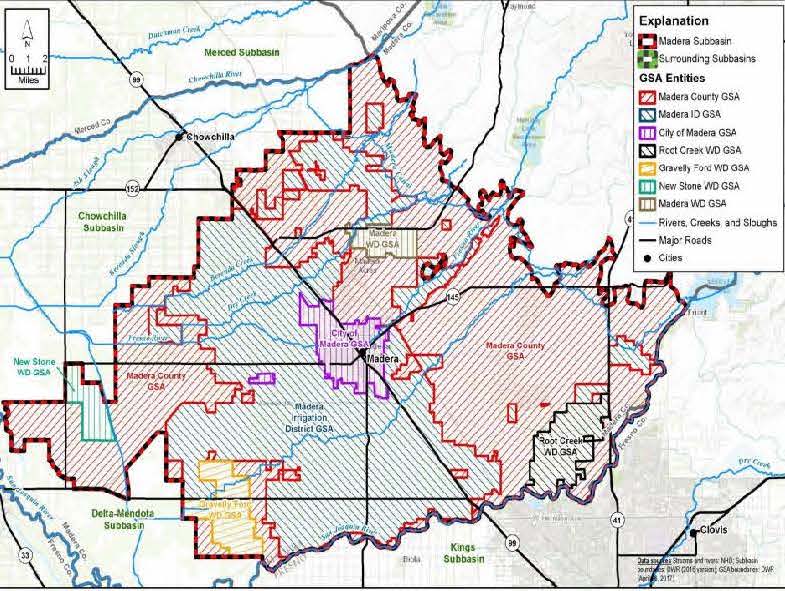Fear and confusion over a new groundwater monitoring technology pushed back the “penalty phase” of Madera County’s attempt to get a handle on its pumping problem.
The Madera County Board of Supervisors was supposed to have voted on penalties for growers who pump more than they’re allowed at its Sept. 13 meeting. But after three hours of debate and hearing from more than 15 members of the ag community about whether the county’s new water monitoring system – Irriwatch – is working properly, supervisors pushed the decision off to Sept. 27.
The meeting was tense with Supervisor David Rogers even calling Irriwatch “junk,” despite multiple verification efforts from universities that have shown the technology is largely accurate.
County staff must now bring revised penalty options to the Sept. 27 meeting even as Irriwatch technology is still going through testing in Madera.
The stakes are considerable as Madera County must reduce excessive pumping in areas it covers that are outside of irrigation districts, meaning they have little to no surface water to water crops and rely almost exclusively on groundwater.
The Madera County Groundwater Sustainability Agency (GSA) had given growers strict pumping allotments already. Penalties for going over those allotments were supposed to be decided at the Sept.13 meeting.
Penalties needed
Now Stephanie Anagnoson, director of water and natural resources for Madera County, must present three revised penalty options.
“Without penalties, there is no incentive to stay within your allocation. And to me that says we’re not compliant with what we’ve agreed to do,” said Anagnoson. “Now, maybe you don’t need a big penalty to do that. Maybe you need a smaller penalty. But I do think that demand reduction through allocations or water budgets that decrease over time was a key part of how we get to sustainability. So I think it’s pretty important.”
In response to the Irriwatch monitoring skepticism, the county is undergoing a “verification project,” testing Irriwatch and gathering a wealth of data to settle the matter.
Irriwatch is one of many methods agencies throughout the state are using to monitor groundwater use and comply with the Sustainable Groundwater Management Act (SGMA.) The law aims to bring over pumped aquifers to sustainable levels by 2040.
To get there, GSAs need to know how much groundwater is being used. Well meters in the county were considered impractical for the Madera County GSA as not all farmers have well meters and it would take time to install and properly calibrate them throughout the GSA.
The GSA worked with the Madera County Farm Bureau and the Madera Ag Water Association, an organization formed by local growers, to review different monitoring methods, said Anagnoson. A panel of growers selected the option of Irriwatch partnered with engineering consultant, Davids Engineering.
Irriwatch uses satellite data to measure the temperature of crops and can compute how much water is used, said Wim Bastiaanssen, CEO of Irriwatch. Irriwatch does this through an algorithm which can determine evapotranspiration of plants through satellite imagery. Evapotranspiration is how plants release water.
Growing concerns
But as pumping restrictions and penalties neared, some farmers in the Madera County GSA have said Irriwatch is inaccurate.
Primarily, growers thought Irriwatch overestimated how much water was being used and that it was inconsistent.
“The entire SGMA implementation system in Madera County is really predicated on some reliable measurement,” said Jack Rice, consultant with the Madera Ag Water Association. “That’s the concern, is people have lost confidence or don’t have confidence in the measurement system.”
But the growers’ claims go against Irriwatch’s track record.
The technology is widely used to monitor water usage and is highly accurate, said Irriwatch’s Bastiaanssen. And it has been repeatedly tested and verified, he added.
“I will always say that the butcher should not check his own meat,” said Bastiaanssen. “So I like to work with universities and other research institutes that carry out those validations so that it’s more independent.”
Irriwatch’s algorithm has been tested and verified by research partners around the world from South Africa to Israel, said Bastiaanssen.
The Surface Energy Balance Algorithm for Land (SEBAL) is the algorithm developed by Bastiaanssen and used in Irriwatch. Multiple peer reviewed research papers have demonstrated SEBAL’s effectiveness through studies in Turkey, China and Iran, to name a few.
Test run prompts more digging
Last year, the county did a test run of Irriwatch with farmers who volunteered to use the technology. Some people reported differences between what they saw on their meters and what Irriwatch was showing.
“It wasn’t really a big group,” said Anagnoson. “But it was enough to make us think as scientists and engineers this was something we wanted to dig in a little bit more on.”
Davids Engineering began a verification project in April. The project includes 17 growers who have given the county and Davids Engineering access to their well meters to compare directly with Irriwatch. There are eight different crop types being monitored across 12,000 acres, mostly permanent crops such as pistachios, almonds and grapes. And the project includes analysis of 90 flow meters.
Since the project began, engineer staff have made weekly visits with every grower involved. They are taking meter measurements, checking irrigation methods and analyzing how meters have been installed, among other tasks.
The project will be completed ahead of the 2023 irrigation season.
“We understand that time is of the essence and that there are a lot of folks who are interested in the results of our findings,” said John Davids, principal engineer at Davids Engineering. “At the same time, we also understand the level of scrutiny that this is going to come under and also that it may play into future decisions that Stephanie and her team may make at a county level.”
Meters not always accurate
One issue that may be confusing growers who see a difference in what Irriwatch is reporting, is meter installation. Unless flow meters are installed to exact specifications, they can be inaccurate.
“For whatever reason, people have a misconception that it’s the meter in and of itself that gets you an accurate reading,” said Anagnoson. “And really, it’s the meter and its installation and ensuring that there is enough laminar flow that gets you accuracy. But I don’t think that’s really well understood.”
Some growers have also pointed out that pistachios have a deeper root structure than other crops and claimed that Irriwatch isn’t correctly computing for pistachios.
Irriwatch’s Bastiaanssen disagreed.
“We look at how much water is used but also we look at the root zone,” said Bastiaanssen. “We take into account the depths of the roots. So pistachios always root deeper. We made nice corrections for that.”
Bastiaanssen, who is from the Netherlands, isn’t surprised by the distrust. When he started in the remote sensing business 35 years ago, people had a hard time believing a satellite could accurately monitor water, he said. Now, the technology is more widely accepted.
“And yet, this has not reached the bulk of the growers,” said Bastiaanssen. “Without having any experience they just like to say, ‘this is not working.’ But that’s not true.”
Share this:
- Click to share on Facebook (Opens in new window)
- Click to share on Twitter (Opens in new window)
- Click to share on LinkedIn (Opens in new window)
- Click to share on Reddit (Opens in new window)
- Click to share on Tumblr (Opens in new window)
- Click to share on Pinterest (Opens in new window)
- Click to share on Pocket (Opens in new window)
- Click to share on Telegram (Opens in new window)
- Click to share on WhatsApp (Opens in new window)
- Click to print (Opens in new window)








